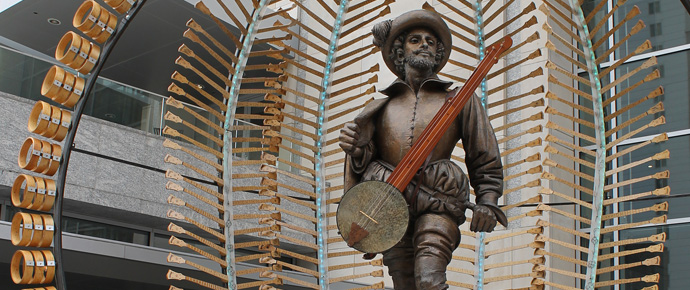
These editorial comments are a contribution from Abby Lee Hood, former IBMA staffer and freelance writer in Nashville. Her opinions do not necessarily reflect those of Bluegrass Today or its sponsors.
If there was ever a time to quietly retire the use of a European colonizers image in World of Bluegrass marketing materials, 2020 would be it. As the IBMA’s annual bluegrass conference and festival moves online to accommodate ongoing COVID-19 safety measures, the organization has a chance to distance itself from the use of Sir Walter Raleigh’s image.
The 31st annual World of Bluegrass will be the first in more than five years not held in Raleigh, North Carolina. The city is, of course, named after Sir Walter himself, and they’re clearly proud; residents can buy a new car at Sir Walter Chevrolet, sip a cup of joe at Sir Walter Coffee, or rent a unit in Sir Walter Apartments. The city has also erected a statue in his honor.
Because of WOB’s location, the IBMA has used Sir Walter’s image in its marketing, like logos and graphic design, for at least a handful of years, including in 2019 and 2017. While it may seem logical and innocent at first blush, national conversations about removing colonial statues and images—like those of Christopher Columbus in Chicago or of Edward Colston in England—bear repeating in the bluegrass community. Bluegrass isn’t immune to critique, especially in the diversity and inclusion department, and Sir Walter Raleigh was no angel.
Before Raleigh came to what is now the United States, he gained the favor of Queen Elizabeth by throwing his cape over a puddle so the queen could cross without soiling her feet. She was enamored, and especially so after the young man returned from fighting at Smerwick. In the autumn of 1580, Irish rebels banded together with Spanish forces to oppose English rule. The English carried out the Siege of Smerwick to quash the rebellion.
After only three days, the English won, further cementing Ireland as the first English colony. Many sources report that every man, woman, and child in the Iron Age fort was beheaded, their bodies tossed into the sea. Several sources say Raleigh himself carried out the executions. While it is impossible to know if he swung the axe on men, on women, or on children, and on how many, we do know Raleigh supported English colonial efforts and likely acted as the Queen’s executioner at the battle.
Shortly after his victory in Ireland, Raleigh returned to the Queen’s court, a sort of swaggering golden boy and her right hand man. As the Queen’s favorite, Raleigh was given leave to colonize what he could in America, and he began planning what would become his first colony. In 1584, 1585, and 1587 Raleigh organized voyages to North America that led to his sponsorship of an English colony on Roanoke Island. Many readers will recognize Roanoke as “The Lost Colony” for its mysterious demise in 1590, so frequently theorized about. However, what happened before the colonizers disappeared is more important.
After receiving assistance in hunting and gathering from local indigenous tribes, the Roanoke colony attacked several of their Native American neighbors. At least one local chieftain was killed in 1586, beheaded in the woods, and other Native American women and children were attacked as tensions rose and relationships between the tribes and the colony eroded.
This interactive map shows a heartbreaking time lapse of indigenous land loss. “Land loss,” is a gentle term that doesn’t accurately depict the genocide of millions of Native Americans in North America. Since the arrival of Europeans, more than 90 percent of the Native population have been murdered or died from disease. Where North America was once 100% Native American, the United States is now only about 2% Native American by population. In his writings, Raleigh regularly referred to indigenous peoples as “savages,” and it is difficult to say just how many were killed under his watch at Roanoke.
After Roanoke failed, Raleigh lost the favor of the court and was imprisoned by Elizabeth’s successor, King James I, in 1603. However, he was freed in 1616 on the condition that he sail to South America and once again begin colonizing, searching for resources and gold. He invaded and pillaged territory under Spanish rule, defying a more pro-Spain King James. He was beheaded in 1618 after a third imprisonment in the Tower of London.
Sir Walter’s accomplishments, in the end, weren’t enough to save him from a new king’s wrath. But in the United States, especially in North Carolina, he enjoys a favor not afforded to him by the Crown. That doesn’t mean it’s right. The IBMA—while like many nonprofits is deserving of support—continues to use Raleigh’s image to market a multi-million-dollar event from which they receive hefty sponsorship dollars and sales revenues. To profit off Raleigh’s image is to profit from his actions, which include murder, colonization, piracy (he also captured and looted multiple Spanish ships), pillaging, and depending on which side of the Atlantic you live on, treason.
Many national conversations about the removal of statues and images are loud, drawing criticism and ire from either side. This year, the IBMA has the opportunity to calmly ditch Raleigh’s image from their marketing and set a precedent moving forward. So far, I have not seen any imagery of Sir Raleigh in this year’s virtual event marketing. And while the contract with the city of Raleigh was renewed for three more years in 2018 and runs until 2021, there’s no law forcing them to use Raleigh’s face on a logo next year. Excluding his face from a conference book or logo doesn’t require a loud press release or social media post, either. Sir Walter could simply fade away to where he belongs: the history books.
As the rest of the United States hotly debates which statues and idols to leave behind, the IBMA is in a particular place to choose who it moves forward with. Moving on without Sir Walter Raleigh is an easy, quiet way to decolonize bluegrass just a little.







